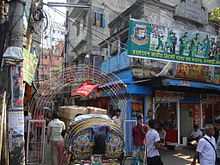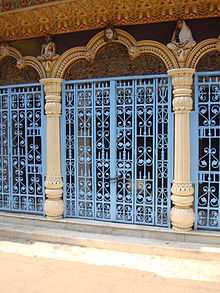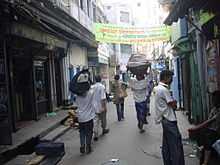Shankhari Bazaar

Shankhari Bazaar (শাঁখারী বাজার) is one of the oldest areas in Old Dhaka (Purana Dhaka). Shankhari Bazaar stretches along a narrow lane, lined with thin slices of richly decorated brick buildings, built during the late Mughal or Colonial period. Despite rampant modifications, accretion, extension over time, even redevelopment, many still bear the testimony of a rich tradition.
Location
Shankhari Bazar is located near the intersection of Islampur Road and Nawabpur Road; and only a block away from the Buriganga River. The place especially belongs to the Hindu peoples.
Background and the name
The area belonged to the Shankhari Community, who borrowed their name from Shankha, a richly decorated bangle crafted from slices of Shankha or conch shells. Shankha is the symbol that indicates that a Hindu woman is married. In the 17th century the Shankhari people were brought by the Mughal emperor, who allotted this place to them for living which later known as Shankhar Bazaar.
Lifestyle of the Shankhari people
The Shankhari people are an artisan caste. Most belong to the Vaishnava branch of Hinduism, and some to the Shakta school; many are vegetarian.[1]
Houses


Shnakhari Bazar was very famous and expensive during the 18th century. The Shankhari people were allotted with places to build houses. Shankhari Bazar is a long narrow street lined by brick buildings which are very old. The widths of buildings were about 12 ft, 70–100 ft in length and 2-3 storeys in height. The highest height of the buildings was four storeys. Each building with its richly decorated elevation in the Mughal or colonial style is characterised by a narrow long corridor and narrow winding staircases placed intermittently between rows of rooms. Each building used to have courtyards. The staircase goes up to the open courtyard on the top floor, surrounded by a richly decorated verandah. Every house used to have a temple room in it.
Temples and Durga Puja
The Hindu Temples are one of the major attractions of Shankhari Bazar. There are many temples on this narrow street. Over the ages Shankhari Bazaar has been elevated to the level of the most popular centre for religious festivities. As one of the most densely populated areas in the world Shankhari Bazaar also has the largest concentration of the Hindus in Dhaka. The temples are small in size but well decorated with ornamental motifs on the entrance and on the walls of the temples. The temples contain the statue of goddess Durga, Ganesha, Shiva etc. Durga Puja is the major festival of Hindu people. During Durga puja, people gathers in Shankhari Bazaar to worship and view goddess Durga. Besides Hindu, Muslims also attend the Puja. In Durga puja, Shankhari Bazaar looks quite nice because of colorful feston, banner etc. Small and temporary food shops are also built during Durga puja. People from different places come to Shankhari Bazaar to see the Puja.
Pannitola

Pannitola is in the RAKHALCHANDRABOSHD LANE of Shankhari Bazaar. The name Pannitola basically came from the first settling area of the Panniwala, people who used to make the foil of tin. The living style of the Panniwala’s was similar to the Shankhari people.
Architecture of Shankhari Bazaar
The architecture of Shankhari Bazar is unique. A creative approach to the problem of congestion is evident especially in the way the courtyards have been built which is used not only for functional efficiency but as devices to incorporate the environmental factors like ventilation, light etc.
Shankhari Bazaar displays a blend of different architectural styles belonging to different periods starting from the Mughals, to the Raj. Stylistic variations in Shankhari Bazaar reveal at least three major stages based on chronologically identifiable features- the late Mughal, early colonial and the Raj. Though the Mughal and colonial style dominated the forms and the geometry of the buildings, motifs from Hindu legends and mythologies are widely found in the surface decorations and architectural details of the buildings. But there are certain architectural elements like the temple, courtyards and the juxtaposition of the courts at different levels, which are unique to this area.
Shankhari Bazar at present
Over the years, Shankhari Bazaar has lost much of its beauty due to urbanization and negligence from the part of the authorities concerned to protect its archeological exquisiteness. Absence of adequate development control rules, complicated by discriminatory land ownership laws compounded by illegal extensions and constructions has resulted in a very complex ownership pattern. Lack of maintenance and repair has resulted in a worn out appearance. Some of the buildings have actually gone beyond any repair due to lack of services and utilities and other urban amenities, multiple ownership of buildings, density of population and the aspirations of the residents.
References
- ↑ Sharmin Naaz (2012). "Shankhari (shell artisan)". In Sirajul Islam and Ahmed A. Jamal. Banglapedia: National Encyclopedia of Bangladesh (Second ed.). Asiatic Society of Bangladesh.
Dhaka Shriti Bismritir Nagari, Author: Muntasir Mamun, Published by Ananna Publications | 3rd Edition, January 2004.